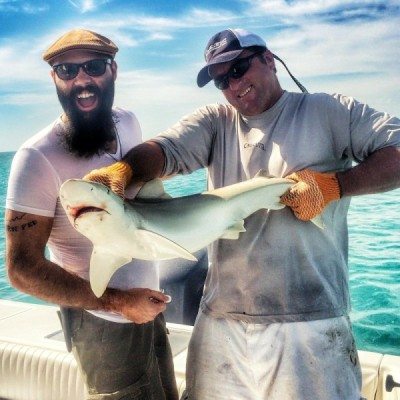On a recent airplane ride back from the mainland I met a couple that was on their way to the Keys for the first time. Of course I asked if they planned to go fishing while they were in Key West. The guy (Dave) said he would love to, but his girlfriend (Karen) gets seasick. Dave also told me he doesn’t fish very often and wasn’t sure he has the experience to catch something really big. I said “What if I told you, we could fish in waters that are always calm and catch fish that are well over 100-pounds on light tackle with absolutely no experience necessary?” We scheduled their shark trip for a Tuesday.
I believe that the shark is one of the best sportfish a newbie to our sport can tangle with and expect to have a pretty high success rate. Somehow they have gained a reputation for being a “dead weight” fighter and I even had an angler tell me he would rather reel in a log than a shark. Moments later his spinning real started screaming and after the third spool-dumping run he was sure he was fighting the kingfish of a lifetime. It turned out to be an 80-pound blacktip shark. I heard no more about pulling in logs, cement blocks or tires for the rest of the day.
I think this preconceived notion stems from sharks being hooked in deep water where they go deep and stay there. The shallow water channels and bays around Key West do not allow them to sit on the bottom and use their weight against the angler. These fish have to run to get away and, boy, can they run.
Plus, the channels around Key West are surrounded by shallow water flats that are calm under nearly any condition. An experienced guide has a list of these areas a mile long and can find a channel that has wind and tide conditions that will work on just about any day. In general we see lemon, black nose, black tip, spinners and bull sharks. Occasionally a hammerhead or tiger will make an appearance as well.
I like to use light tackle and “drop” my anchor to follow the fish with the boat. The current can be pretty strong sometimes, so keeping the fish fairly close is important to prevent a tangle with a trap line or getting cut off on the bottom should the fish flee up on the flat. This also gives the angler a good view of his opponent throughout the entire fight.
The spinner sharks are by far my favorite because they do just as their name suggests. They make leaping jumps and spin like a top on every one, rivaling a tarpon of equal size. Many are lost because they wrap themselves up in the leader and break off.
There are a few tricks for keeping them hooked. As far as rigging, I like to use circle hooks because most sharks are released. Obviously you will need wire leader and I like to use a wind-on leader of monofilament that is heavy enough to prevent abrasion and scuffs from either the shark’s tail or the bottom.
Sharks are willing to eat whatever they find and bait can be just about anything fishy. If you fish in an area that has a lot of small fish such as pinfish or small snappers, I suggest using either a fish head or a whole fish for bait. This keeps the critters from stealing all the meat off the bait and leaving just the skin. A 2- to 3-pound slab of bonita will be mincemeat in seconds if the pinfish find it. I also like to hang a few fish carcasses over the side to add more scent to the water. I feel this works much better than just a block of frozen chum.
Everyone from a tournament pro to a first time angler can have a blast on days when the conditions aren’t so favorable for offshore species or staying in calm water is a must. Remember, most sharks are protected so get his picture and send him off again.


























